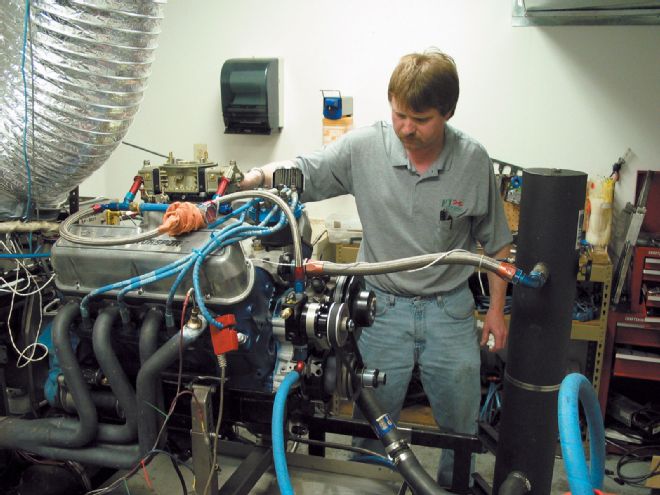
When engine builder Ken Troutman heard the request, he thought it sounded simple enough: One of his customers was sending an engine in for a rebuild. Would it be possible to rig it to run on either gasoline or alcohol? "I thought, 'Sure, it shouldn't be too much trouble,'" says Troutman. "And it wasn't-except we had to learn a few lessons the hard way. Other people can do it too, and hopefully, they can avoid our mistake."
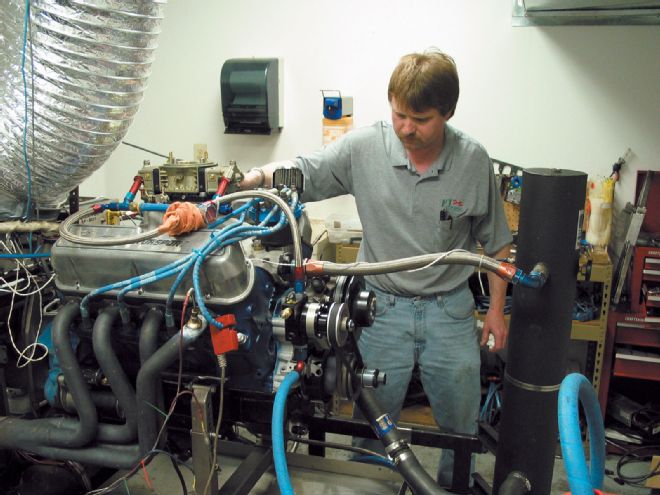 Ken Troutman of KT Engine Development gives our multiple-fuel-burning Ford powerplant a quick visual inspection before beginning another dyno pull.
Ken Troutman of KT Engine Development gives our multiple-fuel-burning Ford powerplant a quick visual inspection before beginning another dyno pull.
Before we get to that mistake, let's set up the background. The engine in question is a Ford small-block that had been powering a Limited Dirt Late Model. It is a wet-sump with 13.2:1 compression and fully ported, cast-iron cylinder heads. It's nothing too exotic, but it's easily capable of producing in excess of 600 hp.
The engine's owner raced at a track that allowed gasoline- or alcohol-powered engines. He wanted the option of running either fuel, but he didn't have the budget for two full-on racing mills.
Too Hot to Handle
"We thought we had the problem solved pretty easily," Troutman says. "We rebuilt the engine and used a high-volume fuel pump that we felt was capable of giving us the pressure we needed. To run effectively, an alcohol motor needs to burn approximately twice as much fuel as a gasoline motor. Unfortunately, the bypass in the pump simply wasn't large enough and couldn't handle the task of the extra flow.
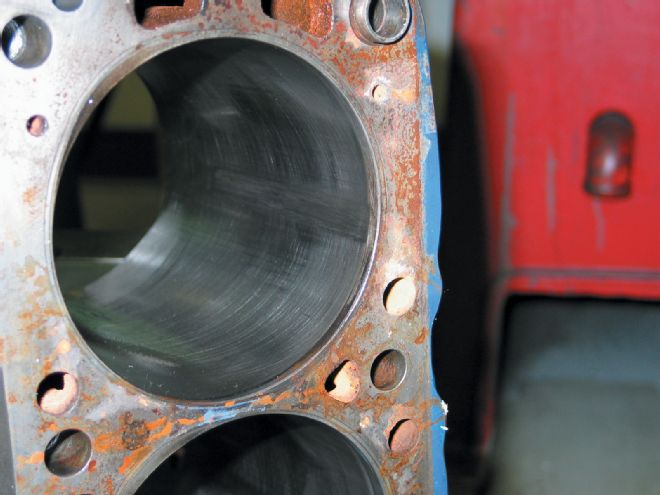 You can see the scuffing that damaged this cylinder bore when the engine ran too lean in the first attempt at building an engine capable of burning either alcohol or gasoline.
You can see the scuffing that damaged this cylinder bore when the engine ran too lean in the first attempt at building an engine capable of burning either alcohol or gasoline.
"The engine ran well on the dyno at lower rpm, but on a full pull, it ran out of fuel and got too lean. We noticed it because the egt (exhaust gas temperatures) got too hot and we saw a sudden drop in power. Fortunately, we caught it pretty quickly and the only damage was a scuff in one of the cylinders and small cracks in two intake seats."
The Fix
The damage was easy to fix, and this is where we came in on the buildup of the gas/alky convertible race engine. The cracks in the intake seats were in the front two combustion chambers, and the scuffed cylinder was also in the front of the block. The heads are Ford's N351 castings, which do not come with hardened valve seats. Troutman had already installed hardened seats for all the exhaust valves because alcohol race fuel lacks the lead that protects the exhaust seats when racing with gasoline. To fix the cracks, he simply cut out the two damaged intake seats-being careful not to cut into the water jacket-and installed hardened replacement seats for those two valves. The scuff in the cylinder bore was similarly easy to fix. It disappeared by simply rehoning the cylinder, which didn't even increase the bore size appreciably.
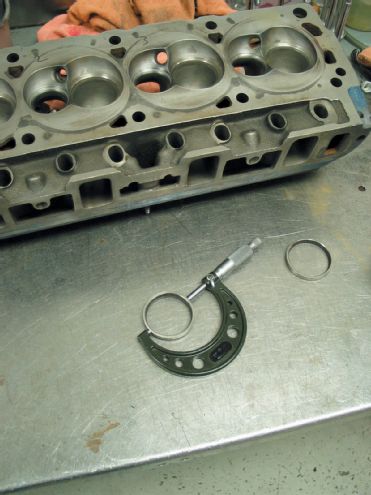 New hardened seats had to be pressed in to fix the two intake seats that cracked. All the exhaust ports already had hardened seats.
New hardened seats had to be pressed in to fix the two intake seats that cracked. All the exhaust ports already had hardened seats.
Rebuild
Since the point of this conversion was to keep the engine as standard as possible, we won't get bogged down in a blow-by-blow of every part installed. Instead, we'll just concentrate on what was done to help the engine run well on a diet of either gasoline or alcohol. The biggest obstacle, obviously, is the fuel pump. After much research, Troutman settled on a belt-driven pump sold by BLP Products that is a vast improvement-in terms of available flow-over any pushrod driven pump. To allow a variety of mounting options, BLP pumps are available with an adjustable mounting bracket and a mandrel that mounts to the harmonic balancer that allows several options for mounting drive pulleys. Our setup is underdriven by a small cog-belt pulley mounted to the mandrel. Troutman adjusted the pump to provide between 9 and 12 pounds of pressure at race speeds.
Because alcohol can easily contaminate the oil supply and potentially cause a bearing failure, Troutman switched from a low-tension to a standard racing ring package. The change can cost a little in terms of parasitic friction losses, but it does reduce piston blow-by and cuts down the opportunity for the alcohol fuel to enter the oil supply.
In addition to its complete inability to live in harmony with oil, alcohol also requires other considerations when switching over from gasoline. One factor is that the ideal air/fuel ratio for alcohol is around 7:1, more than twice that of gasoline which burns best at a ratio of 14.5:1. This accounts for the extra demand on the fuel pump. Another factor is that alcohol is more resistant to detonation and can typically live with a higher compression ratio. This is because it burns cooler and much more fuel is traveling through the combustion chamber than a gas engine. Troutman took advantage of this by retarding the cam timing two degrees over his regular setup.
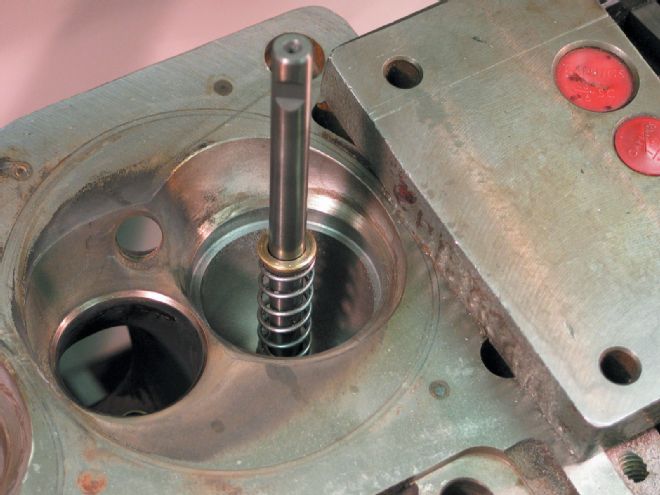 This shows how much cutting was done before the new, hardened intake seat was pressed in.
This shows how much cutting was done before the new, hardened intake seat was pressed in.
Once the fuel pump is in place, the extra fuel demands can be handled simply by swapping out carburetors. For gasoline, this engine will run with an 830-cfm Holley four-barrel with 85-size jets. Alcohol requires a big step up. In place of the 830 carb, a 900-cfm annular discharge Holley is bolted up, and the jets are bumped up in excess of 188. The end result, though, is that conversion from gasoline to alcohol or vice versa is a relatively simple process. Just swap carburetors, adjust the fuel pump (or replace the belt-driven pump with a standard unit), and make a timing change (max power on gasoline was at 22 degrees, while alcohol seemed to run best at 21 degrees of timing).
On the Dyno
The dyno test was set up in two distinct stages. First, the engine was configured for gasoline (fuel pressure and carburetor) and dyno tuned. Then everything was performed again in the alcohol-burning configuration. The gas combo worked best with the timing set at 22 degrees, creating a peak horsepower number of 615.4 at 6,800 rpm and a broad torque powerband in excess of 535 lb-ft from 4,800 to 5,900 rpm. Volumetric efficiency maxed out at 92.6 percent at 5,200 rpm.
Alcohol performed best at 21 degrees advance timing. Max power jumped 39.8 hp to 655.2 at 6,400 rpm. Torque also increased (542.9 lb-ft at 6,300 rpm), although it moved higher in the rpm range. More power could possibly be found in this combination with a little more effort. The engine was again showing signs of beginning to run slightly lean at the upper rpm limits. The easy solution is simply to switch out for larger jets, but 188s were already in the carburetor and Troutman didn't have any larger jets in his shop.
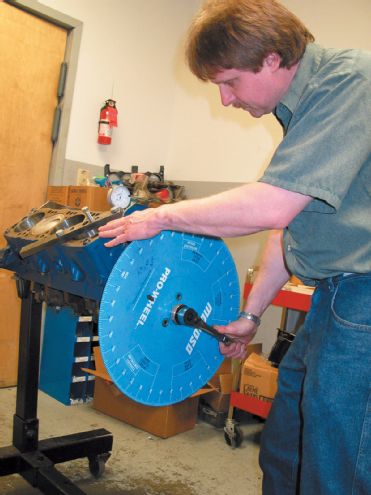 The cam timing was retarded two degrees over Troutman's normal setup for gasoline.
The cam timing was retarded two degrees over Troutman's normal setup for gasoline.
"We could have spent the time and made the minute adjustments to tune every last ounce of power out of it," he explains, "but practically speaking, that wouldn't do much good. I'm in North Carolina and the customer is in West Virginia, so even if I got the perfect jet in it for the elevation and atmospheric conditions here, it's going to be wrong for him at his home track. Plus, I'm also running headers that aren't ideal. They are 1 5/8 inches with no step-up feeding into 3-inch collectors. This engine could use larger pipes. It would help increase the high-rpm power and keep it from falling off on the top end, but since the exhaust restriction was consistent from the gasoline test to the alcohol test, it really doesn't matter that much. The test here was to see the difference in how the engine handled the two different fuels-not to get a single horsepower number to go home and brag about."
In an effort to make the comparison results as accurate as possible, some changes that could have been made to improve peak horsepower (jet changes, header pipe changes, etc.) were not made. Unfortunately, all these changes seemed to especially hurt the power after peak when burning alcohol. Troutman felt that a few simple changes could have significantly helped the alcohol numbers to keep from dropping after the horsepower peak. Overall, we were very happy with both the power and torque curves this engine produced burning both fuels.
Gasoline Alcohol RPM Torque Horsepower Torque Horsepower 4,100 533.7 416.6 537.8 419.8 4,200 533.8 426.9 537.3 429.7 4,300 533.3 436.6 537.5 440.1 4,400 534.0 447.4 537.0 449.9 4,500 534.7 458.1 537.1 460.2 4,600 534.8 468.4 537.2 470.5 4,700 534.9 478.7 537.9 481.4 4,800 535.0 489.0 538.0 491.7 4,900 535.1 499.2 538.1 502.0 5,000 535.8 510.1 538.2 512.4 5,100 535.9 520.4 538.3 522.7 5,200 535.4 530.1 539.6 534.3 5,300 535.5 540.4 539.2 544.1 5,400 535.6 550.7 539.3 554.5 5,500 536.4 561.7 539.5 565.0 5,600 536.5 572.0 539.0 574.7 5,700 535.4 581.1 539.2 585.2 5,800 535.6 591.5 539.3 595.6 5,900 535.7 601.8 540.1 606.7 6,000 531.5 607.2 540.3 617.3 6,100 521.4 605.6 540.5 627.8 6,200 515.7 608.8 542.6 640.5 6,300 504.8 605.5 542.9 651.2 6,400 502.7 612.6 537.7 655.2 6,500 493.6 610.9 524.7 649.4 6,600 486.6 611.5 512.2 643.7 6,700 481.4 614.1 497.0 634.0 6,800 475.3 615.4 481.1 622.9